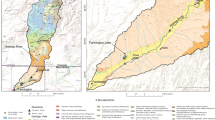Abstract
The copper mine at Kilembe in the Ruwenzori Mountains in western Uganda ceased to operate in 1978 but a steady flow of contaminants, including Cu, Co, Ni, Zn, Cd, and sulphate, continues to enter the Nyamwamba-Rukoki River, which passes through Queen Elizabeth National Park, and finally flows into Lake George. Lake George is quite shallow, alkaline, and highly eutrophic. Measuring mass-flow of contaminants, water, and suspended solids in the Rukoki River near Kasese allowed us to estimate their input into Lake George. Grid sampling of lake sediments indicated that the contaminants settle near the two mouths of the river; low concentrations in a drill core in the centre of Lake George indicate that further dispersion within the lake is small. Sequential extraction experiments on lake sediments and lake water analyses suggest low bioavailability of the heavy metals. We conclude that Lake George is a highly resilient system that efficiently immobilises contaminants. Though there is no health risk for the population under present environmental conditions, a reduction of the contaminant load is desirable.
Similar content being viewed by others
Author information
Authors and Affiliations
Corresponding author
Rights and permissions
About this article
Cite this article
Hartwig, T., Owor, M., Muwanga, A. et al. Lake George as a Sink for Contaminants Derived from the Kilembe Copper Mining Area, Western Uganda. Mine Water Environ 24, 114–123 (2005). https://doi.org/10.1007/s10230-005-0082-2
Received:
Accepted:
Issue Date:
DOI: https://doi.org/10.1007/s10230-005-0082-2




